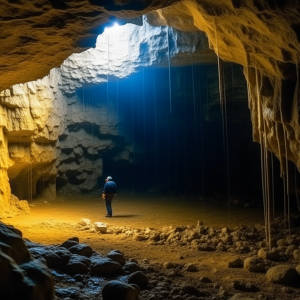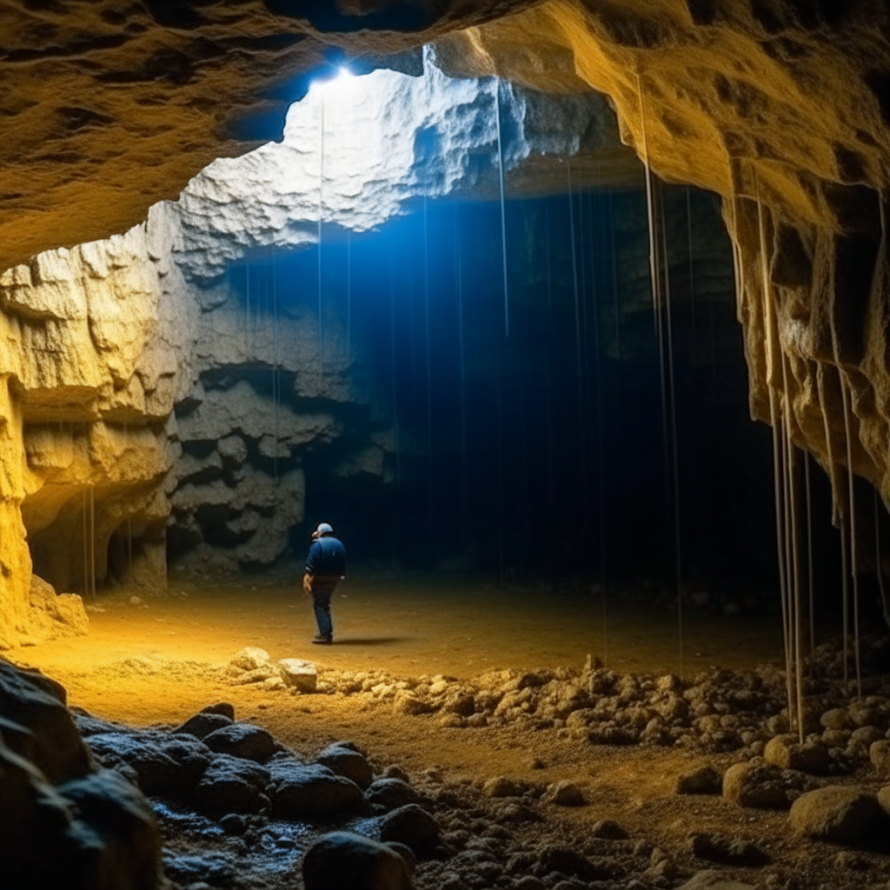Investigating the Hidden World Beneath Our Feet
In various situations, such as natural disasters, nuclear emergencies, or even as a strategic choice for particular lifestyles, the ability to survive underground can be a tough yet vital talent. When it comes to the art of surviving underground, there are a few crucial things that you should consider, regardless of whether you are building a shelter or adjusting to an existing underground environment.
 There is a hidden world beneath our feet that is mainly undiscovered and enigmatic; this is the underground. The surface of the Earth may be busy with life, but the underground is much less studied. Many people have questioned how long it is possible to survive underground, whether it is for the purpose of surviving a terrible catastrophe or simply for the pure joy of adventure. This fascinating topic will be the focus of our discussion today, and we will learn the keys to surviving in the deepest parts of the earth.
There is a hidden world beneath our feet that is mainly undiscovered and enigmatic; this is the underground. The surface of the Earth may be busy with life, but the underground is much less studied. Many people have questioned how long it is possible to survive underground, whether it is for the purpose of surviving a terrible catastrophe or simply for the pure joy of adventure. This fascinating topic will be the focus of our discussion today, and we will learn the keys to surviving in the deepest parts of the earth.
First and foremost, it is essential to recognize that the capacity to survive underground is contingent upon a number of different circumstances. The reasons for going underground, the readily available resources, the individual’s level of expertise and knowledge, and the underground general conditions are all factors that come into play.
Location and Structure
The success of an underground shelter is directly proportional to the site that is chosen for those shelters. It is of the utmost importance to have stable soil and adequate drainage to prevent problems like flooding, which might put the refuge’s safety and long-term viability at risk. Walls and ceilings should be reinforced during the construction of the shelter in order to improve the structure’s structural integrity and prevent collapses. In selecting or constructing the underground refuge, it is important to consider geological stability, proximity to water sources, and accessibility.
If you decide to go with a purpose-built building, make sure that it complies with all of the safety criteria and is able to handle any potential pressures from the outside. Naturally occurring caves may have a certain degree of inherent stability; nonetheless, they may still require reinforcement to meet the safety criteria necessary for long-term living. The following is a checklist that can be used to find an appropriate location and ensure the reliability of the structure:
- Conduct a geological survey of the area.
- Assess soil stability and drainage conditions.
- Reinforce walls and ceilings with appropriate materials.
- Comply with safety standards and regulations for underground structures.
Ventilation
Keeping a steady supply of fresh air is vital for living in an underground environment. Install a dependable ventilation system fitted with filters to limit the amount of contaminants allowed to enter the space. To eliminate the possibility of a single point of failure, it is essential to have redundant ventilation sources. Natural ventilation options, such as strategically located vents and mechanical systems, should be considered. Adequate airflow maintains a constant supply of oxygen and contributes to regulating temperature and humidity within the underground space. The following is a checklist that can be used to achieve adequate ventilation:
-
- Install a mechanical ventilation system with filters.
- Incorporate redundancy in ventilation sources.
- Implement natural ventilation methods, such as vents or ducts.
- Regularly inspect and maintain ventilation systems.
Water Supply
The establishment of a dependable water supply is of the utmost importance for the maintenance of life underground. The excavation of wells, the installation of water storage tanks, or the implementation of a filtration system may be required in this regard, depending on the location. When storing water for an extended period, storing it in airtight containers is essential to avoid contamination and guarantee a clean and safe water source. In order to guarantee a reliable water supply underground, you should take into consideration the following checklist:
-
- Dig wells or implement water storage systems.
- Install a water filtration system to ensure purity.
- Store water in airtight containers to prevent contamination.
- Regularly test and treat stored water for safety.
Food Storage
When staying underground for an extended period of time, it is necessary to have adequate and strategic food storage. Stockpiling non-perishable, nutrient-rich foods with an extended shelf life is important to meet the residents’ nutritional requirements. When it comes to growing fresh vegetables, you should also investigate environmentally friendly methods such as hydroponics and indoor gardening. For the purpose of preserving one’s health during extended periods underground, it is essential to have a food supply that is both comprehensive and varied. To ensure efficient food storage and long-term sustainability, the following is a checklist:
- Stockpile non-perishable foods with long shelf lives.
- Consider nutrient-rich options to meet dietary needs.
- Explore indoor farming or hydroponics for sustainable food production.
- Rotate and monitor food supplies to prevent spoilage.
Energy Sources
Access to dependable and environmentally friendly energy sources is necessary to operate vital equipment and keep the living environment underground comfortable. Power can be generated from renewable sources such as solar panels, wind turbines, or generators, and using energy-efficient technologies contributes to the conservation of resources. For the purpose of building a sustainable energy source, the following checklist should be considered:
- Install alternative energy sources such as solar panels or wind turbines.
- Use generators as backup power sources.
- Implement energy-efficient technologies for power conservation.
- Regularly maintain and monitor energy systems.
Waste Management
The establishment of a waste disposal system that is both efficient and effective is essential for the maintenance of hygiene and the prevention of the spread of diseases underground. A clean and habitable living environment is also contributed to by using appropriate waste management procedures. When it comes to efficient waste management underground, take into consideration the following checklist:
- Implement a waste disposal system with designated areas for different types of waste.
- Compost organic waste to reduce the environmental impact.
- Recycle materials to minimize waste generation.
- Regularly dispose of waste in a safe and controlled manner.
Security
For those who wish to survive underground, security is of the utmost importance, and it is essential that the entry be designed with defense in mind. Ensuring the safety of the people who live there requires that the entrance be easily defendable against any potential dangers that may arise. Installing security measures such as cameras, alarms, and reinforced doors is important to establish a secure living environment and discourage people from breaking in. Listed below is a checklist that can be used to improve the safety of an underground shelter:
- Design the entrance with defensibility in mind.
- Install surveillance cameras for monitoring key areas.
- Implement an alarm system to alert inhabitants to potential threats.
- Use reinforced doors to enhance security.
Communication
It is necessary to have a reliable connection with the outside world in order to stay informed and to have the ability to coordinate reactions to changing conditions. In order to maintain connectivity even in difficult circumstances, it is necessary to implement various communication technologies, including radios, satellite phones, and other long-range devices. For the purpose of developing efficient communication systems, the following is a checklist:
- Install a variety of communication devices for redundancy.
- Test communication systems regularly to ensure functionality.
- Have a designated communication protocol for emergencies.
- Stay informed about external developments through reliable channels.
Medical Supplies
When it comes to managing health concerns underground, having adequate medical supplies is really necessary. A full first aid bag should be assembled, and important prescriptions should be stocked up so that you can deal with typical medical problems. Because of the potential health hazards linked with confinement, it is important to adopt preventative steps to ensure that all occupants continue to enjoy good health. For those who are underground, here is a checklist for medical preparedness:
- Stock essential medications for common health issues.
- Create a comprehensive first aid kit with the necessary supplies.
- Train inhabitants in basic first aid and emergency medical procedures.
- Establish protocols for addressing medical emergencies.
Psychological Well-Being
Establishing a living environment that is both comfortable and well-lit is necessary to preserve one’s mental health while living underground. Through the creation of an environment that is conducive to mental health, you can combat feelings of isolation and claustrophobia. In order to offer a sense of normalcy and ease tension, it is important to make plans for recreational activities such as reading, playing games, or using entertainment devices. An underground setting has a number of challenges that must be addressed in order to ensure psychological well-being:
- Design living spaces to maximize natural light and ventilation.
- Create communal areas for social interaction.
- Provide recreational activities to alleviate stress and boredom.
- Establish a support system for mental health needs.
Training and Drills
To ensure that all residents are aware of the procedures to follow in the event of an emergency, it is vital to conduct regular training and drills. Simulations should be carried out to prepare for various scenarios, including evacuation plans and responses to potential dangers. Training helps foster self-assurance and readiness, which ultimately contributes to an increase in the underground community’s overall level of safety. A checklist for efficient training and preparedness in the event of an emergency is as follows:
- Conduct regular drills for evacuation and emergency response.
- Train inhabitants in the proper use of safety equipment.
- Review and update emergency procedures based on lessons learned.
- Foster a culture of preparedness through continuous education.
Community and Cooperation
When it comes to long-term survival underground, cultivating a feeling of community is absolutely necessary. To ensure that order and collaboration are maintained, it is necessary to establish rules, responsibilities, and clear communication routes. When individuals are provided with a supportive community, it assists them in coping with the difficulties that come with living underground and enhances the overall resilience of the group. In order to construct a society that is cohesive and cooperative, the following is a checklist:
- Establish clear rules and guidelines for communal living.
- Assign responsibilities to different members for various tasks.
- Foster open communication and address conflicts promptly.
- Encourage collaborative activities to strengthen the sense of community.
The incorporation of these checklists and many considerations into your underground survival plan has the potential to improve the occupants’ overall well-being, as well as their safety and sustainability. Make adjustments to these suggestions per the particular conditions, and regularly evaluate and enhance your underground living arrangements to achieve the highest possible level of preparedness.
Budget-Friendly Energy Hacks for a Cozy Winter Home
Winter Wonderland on a Budget: Energy-Saving Hacks for a Cozy Home When the temperature begins to drop and a coating of frost begins to blanket the streets, there is nothing quite like the feeling of being able to be warm and cozy in the comfort of your own home. However, because heating expenditures tend to […]




